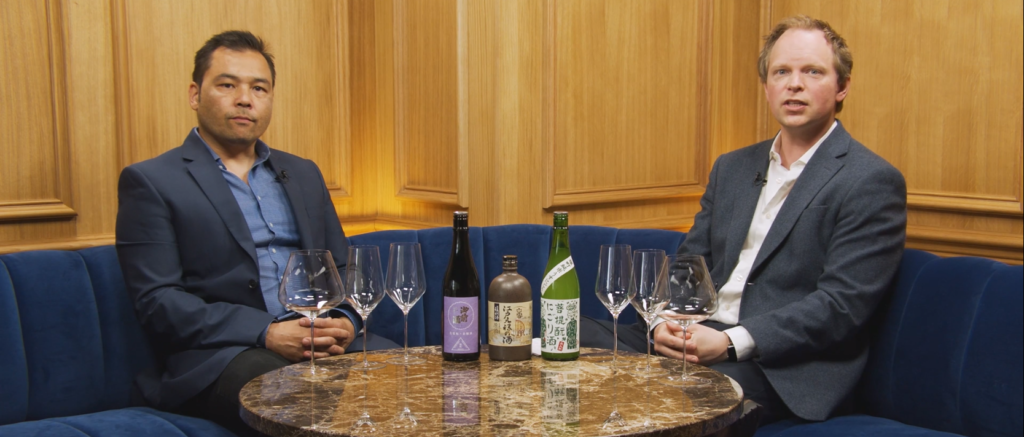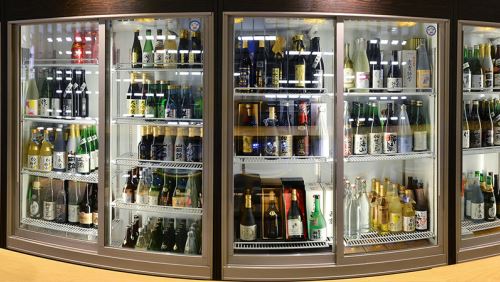
In this hour-long feature for 67 Pall Mall TV our Director, Oliver Hilton-Johnson, talks with industry professional Barry McCaughley about sake’s long and varied history including: early rice cultivation, introduction of Koji, evolution in techniques via the monks & temples, commercialisation, prohibition, Edo Period stability and, finally modern day trends!
A lot is covered, providing an engaging and comprehensive look at sake’s past and present.
– Gozenshu “Misty Mountain” Junmai Bodaimoto Usu-nigori
– Shirayuki “Genroku Redux” Junmai
– Gozenshu “Mountain Castle” Junmai Bodaimoto Nama Kijoshu (now discontinued and replaced with a pasteurised version).
Watch the full episode over on 67 Pall Mall TV
During the COVID lockdown our Director, Oliver, was invited along to the studios in the famous wine establishment of 67 Pall Mall give an Introduction to Sake. Here he talks to industry professional Barry McCaughley.
– Yauemon “Autumn Leaves” Honjozo
– Yauemon “Waning Moon” Junmai
– Konishi Silver Ginjo
– Fukukomachi “Gentle Breeze” Junmai Ginjo
– Fukukomachi “Silent Blossom” Junmai Daiginjo
– Fukukomachi “Hidden Glade” Daiginjo
You can watch this episode for free over on 67 Pall Mall TV and, buy purchasing the sakes, you can taste along too!
It’s been a while since I did an absolute basics for sake so, if you’re new to sake and just want to find out more then this is the session for you! You don’t even need to order any sake for this one, just tune in and find out about sake. To join in just click on the Zoom link below on 18th at 7pm!
ABSOLUTELY FREE
https://us02web.zoom.us/j/83397457797?pwd=M1NFSUI4NVZYbXZWUVNNY0x2R0xLZz09
Meeting ID: 833 9745 7797
Passcode: 395819
If you don’t have Zoom then please click the link well in advance and download!
The first in our series of online tastings and lectures, led by our Director and Sake Specialist Oliver Hilton-Johnson, all about namazake.
Including:
What is namazake? Why is sake pasteurised? What are the flavours and aromas you can expect from a namazake? How is namazake best stored? How to tell if namazake is ‘off’.

Looks great but – even though refrigerated – not good for long term sake storage!
Often I get asked the best way to store sake, this is particularly important during the festive or other gift-giving seasons as sake can often sit around for a while. I guess the first thing to address is how long sake lasts, so please read my How Long Sake Lasts blog post.
Now that’s cleared up it’s very simple, sake has two enemies: heat and light. (more…)

Sake will, of course, last longer when it is stored correctly.
The question of how long sake lasts is actually quite difficult to answer and, certainly, there are a few breweries experimenting with ageing and maturing sake longer than what we traditionally consider a ‘safe’ or ‘wise’ period. This process is distinct from koshu (intentionally aged sake for longer than three years) which tends to have rich and deep umami-led flavours, often they are quite sweet too. What I’m talking about here are brewers who are either maturing their sake themselves for prolonged periods of time (but generally less than three years) or designing the sake to be sold ‘fresh’ and then develop over time. Some brewers are even doing this with namazake (unpasteurised sake), some Muroka Nama Genshu (unfiltered, unpasteurised & undiluted) rather suit a bit of maturation! (more…)

A while back I wrote a post detailing which types of sake you can expect to be gluten free and which might contain some. In that post we learnt that some types of sake have a little added, distilled alcohol (often listed as “brewers’ alcohol” on the bottle). Naturally, this begs the question why? Why does sake have added alcohol? (more…)

I was recently asked is sake gluten free or not (some of you may have noticed that on some of our bottles gluten is indeed listed as an allergen). The answer, in a word, is complicated.
There are a lot of sake myths and mis-information out there so here are a few facts we hope will clear things up!
In summary the rough, boiling-hot gut-rot of yore is no more! Instead, as interest has grown and technology (both manufacturing and transportation) has improved, the quality of sake available in the UK has improved immeasurably.
We hope that has cleared up some of the sake myths and encouraged you to give it a go! Pop on over to our shop to see what you can find.
In our shop we quote a series of ‘Master Specs’ for all our sake. These are not special Tengu Sake Master Specs in so much as we didn’t come up with the system, these are metrics given by most brewers. As the name suggest you kind of have to be an expert to really understand what they mean and how they’ll affect you experience. I can’t fully explain them all here but what I can give you is an insight into what they mean, future blog entries will expand (under master specs tag), and tastings I host will help your understanding so do pop along!
The last thing I want is for these specs to be intimidating. Sake is a very involved subject and the rabbit-hole goes very deep! These specs are design for those that already know a lot about sake. However, the more you drink it and the more you learn about it (this blog is a good place to start) the more you’ll begin to understand what these stats mean.